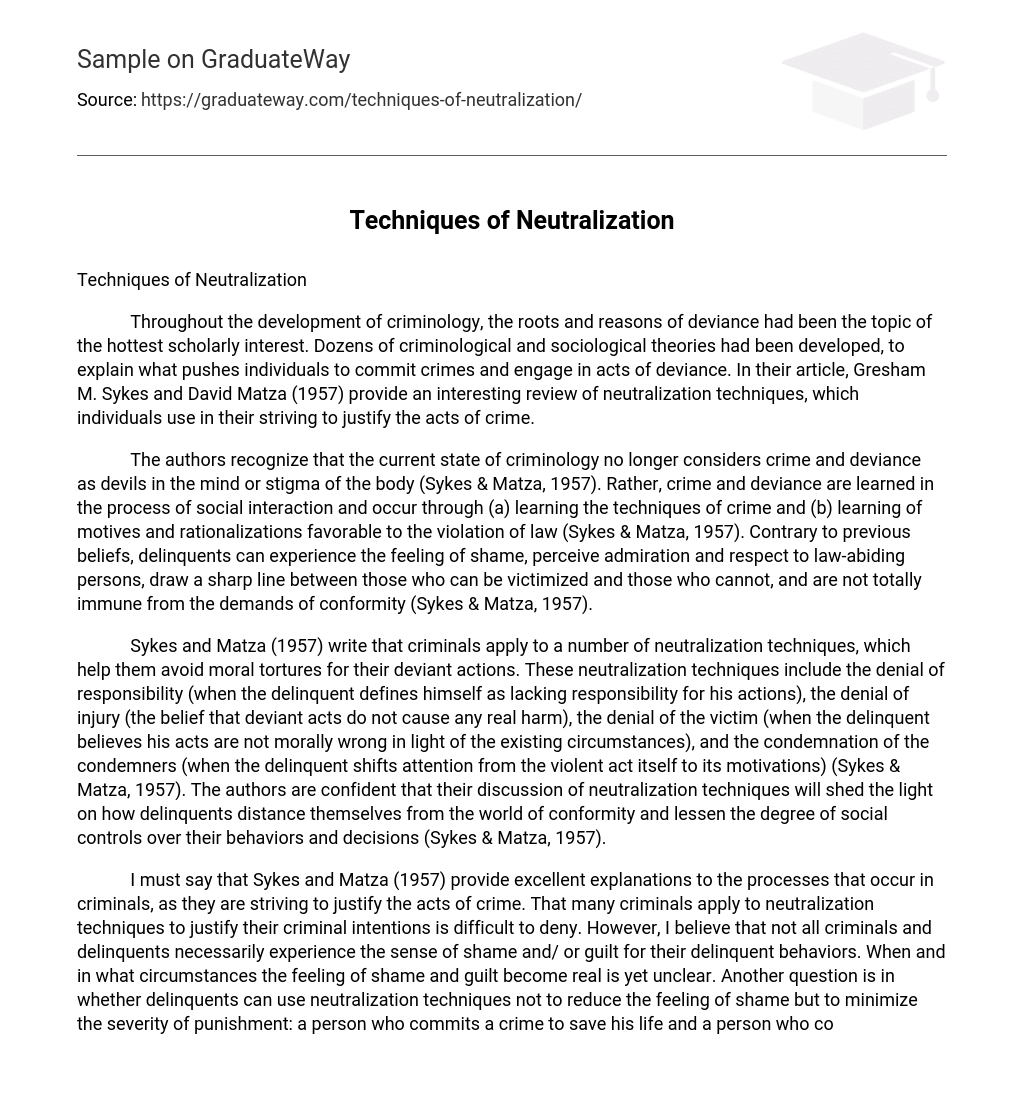Throughout the development of criminology, the roots and reasons of deviance had been the topic of the hottest scholarly interest. Dozens of criminological and sociological theories had been developed, to explain what pushes individuals to commit crimes and engage in acts of deviance. In their article, Gresham M. Sykes and David Matza (1957) provide an interesting review of neutralization techniques, which individuals use in their striving to justify the acts of crime.
The authors recognize that the current state of criminology no longer considers crime and deviance as devils in the mind or stigma of the body (Sykes & Matza, 1957). Rather, crime and deviance are learned in the process of social interaction and occur through (a) learning the techniques of crime and (b) learning of motives and rationalizations favorable to the violation of law (Sykes & Matza, 1957). Contrary to previous beliefs, delinquents can experience the feeling of shame, perceive admiration and respect to law-abiding persons, draw a sharp line between those who can be victimized and those who cannot, and are not totally immune from the demands of conformity (Sykes & Matza, 1957).
Sykes and Matza (1957) write that criminals apply to a number of neutralization techniques, which help them avoid moral tortures for their deviant actions. These neutralization techniques include the denial of responsibility (when the delinquent defines himself as lacking responsibility for his actions), the denial of injury (the belief that deviant acts do not cause any real harm), the denial of the victim (when the delinquent believes his acts are not morally wrong in light of the existing circumstances), and the condemnation of the condemners (when the delinquent shifts attention from the violent act itself to its motivations) (Sykes & Matza, 1957). The authors are confident that their discussion of neutralization techniques will shed the light on how delinquents distance themselves from the world of conformity and lessen the degree of social controls over their behaviors and decisions (Sykes & Matza, 1957).
I must say that Sykes and Matza (1957) provide excellent explanations to the processes that occur in criminals, as they are striving to justify the acts of crime. That many criminals apply to neutralization techniques to justify their criminal intentions is difficult to deny. However, I believe that not all criminals and delinquents necessarily experience the sense of shame and/ or guilt for their delinquent behaviors. When and in what circumstances the feeling of shame and guilt become real is yet unclear. Another question is in whether delinquents can use neutralization techniques not to reduce the feeling of shame but to minimize the severity of punishment: a person who commits a crime to save his life and a person who commits the same crime to rob the victim will face different risks of punishment.
Finally, Sykes and Matza (1957) seem to forget that crime is not always the product of social influences; a multitude of internal and external factors lead individuals to commit a crime. Of all children living in a socially disadvantaged neighborhood, only few will choose a criminal path. I suppose that Sykes and Matza (1957) provide a useful explanation to the complex decision-making processes in criminals but there are questions that must be answered, to better explain the social and psychological origins of crime. (a) Do criminals apply to neutralization techniques to reduce the feeling of shame and guilt or to reduce the severity of potential punishment? (b) What factors are responsible for the use of neutralization techniques by delinquents (here, professionals must pay special attention to the internal characteristics and psychological portraits of each particular criminal)? (c) What makes delinquents choose one particular type of neutralization technique? (d) How often do criminals experience the feeling of shame and guilt and how frequently do they apply to neutralization? All these questions require professional answers, to create a better picture of crime and to understand the origins and development of the criminal intentions from within.
References
Sykes, M. & Matza, D. (1957). Techniques of neutralization.





